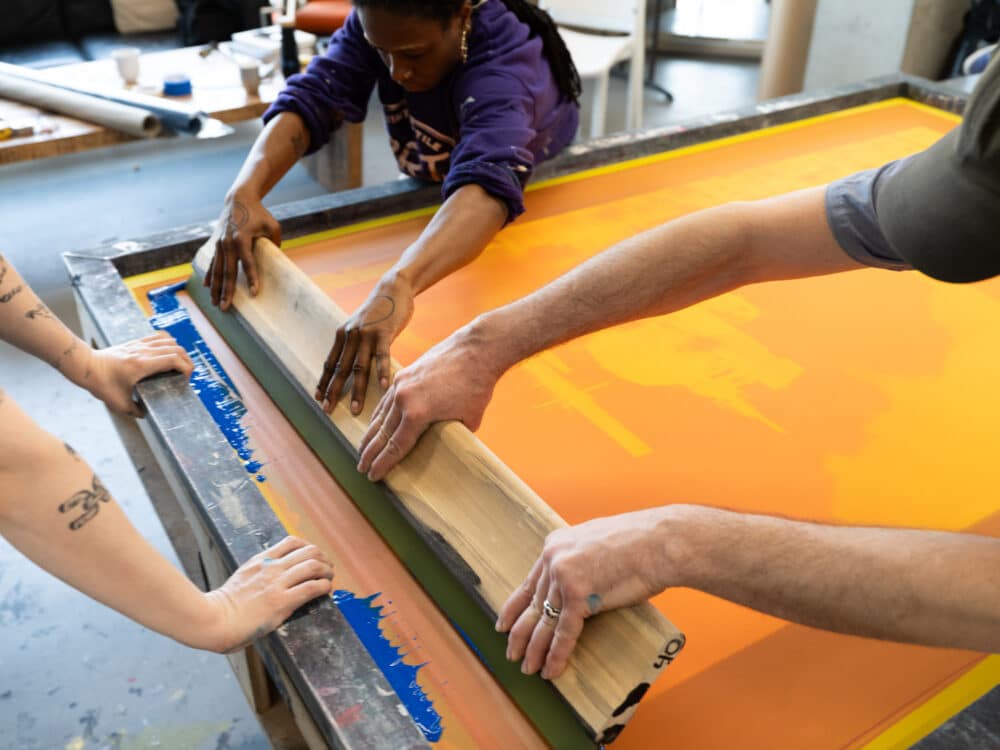ChatGPT said: 10:9 Design Abilene: your community choice for custom apparel and branding
The Important Guide to Understanding Screen Printing and Its Versatile Utilizes
Screen printing has a rich background that dates back to old times, progressing into an advanced method made use of throughout numerous sectors today. This guide discovers the ins and outs of the screen printing process, describing its applications in advertising, style, and home style - 10:9 Design contact. Understanding these fundamentals can open creative potential for both creative and business jobs. The following sections will expose vital tips and strategies to boost one's screen printing undertakings
The History of Screen Printing
Although screen printing has origins that map back centuries, its development reflects the imaginative and technical developments of different societies. Originating in ancient China, the method was initially made use of for decorating textiles and later spread to Japan, where it became essential to Ukiyo-e woodblock printing. The technique shifted to Europe in the 18th century, where it acquired popularity among artisans and business printers. The creation of image emulsion in the 20th century reinvented screen printing, enabling more detailed designs and higher efficiency. Musicians like Andy Warhol additionally drove its popularity, using the medium to create iconic jobs that combined commercialism and great art. By the late 20th century, screen printing had established itself as a functional technique, used in vogue, advertising, and art. Today, it remains to develop, incorporating electronic technology and broadening its applications across numerous markets.
The Screen Printing Process Explained
Screen printing transforms artistic visions right into concrete designs via a collection of accurate actions. Initially, a photo is produced and then moved onto a screen, generally made of fine mesh material extended over a framework. A light-sensitive solution is used to the screen, which is exposed to light, hardening in locations not covered by the photo. After cleaning out the unhardened emulsion, a stencil is formed.
Next off, the screen is placed over the substratum, whether it be fabric, paper, or another product. Ink is then pushed via the open locations of the pattern using a squeegee, depositing the layout onto the substrate listed below. This process can be duplicated for several colors, needing separate displays for every color. The printed item is healed making use of warmth to assure the ink sticks effectively, resulting in a durable, vivid style prepared for usage.
Types of Screen Printing Techniques

Additionally, specialty methods, such as discharge screen printing, eliminate dye from the textile to create softer prints, while aluminum foil screen printing applies metallic aluminum foil to achieve a glossy coating (10:9 Design Company). Each method supplies distinct features, providing to various creative needs and manufacturing ranges, inevitably broadening the opportunities within the screen printing domain
Applications of Screen Printing in Different Industries

Furthermore, the signage and marketing industries use screen printing for creating appealing screens and banners. This method permits for bold colors and complex designs that capture interest. In electronics, screen printing is used for using conductive inks to motherboard, necessary for component links. In addition, the home decoration market embraces screen printing to produce distinctive designs on fabrics and wall surface art. Generally, screen printing functions as a critical device across diverse fields, boosting products with personalized and visually attractive graphics.
Tips for Effective Screen Printing Projects
While embarking on a screen printing job, careful focus to information can substantially boost the final result. Initially, choosing high-grade products is important; this includes the screen, inks, and substrates. Making use of ideal mesh counts can affect ink deposition and detail resolution. Prep work is equally important; thorough cleaning of screens and correct exposure times ensure crisp prints.
Next off, accurate registration is important for multi-color prints. Using placement devices can aid accomplish accurate layering. Additionally, screening prints on scrap products before manufacturing assists recognize prospective problems without squandering resources.

Often Asked Inquiries
What Products Are Ideal for Screen Printing on Material?
Cotton and polyester blends are excellent for screen printing on material because of their durability and ink absorption. In addition, specialty materials like silk or canvas can generate unique structures and surfaces, enhancing the overall style quality.
How Do I Tidy and Maintain Screen Printing Devices?
To cleanse and preserve screen printing devices, one should regularly wash screens with suitable solvents, examine mops for wear, lubricate moving components, and shop all things in a dry, dust-free setting to lengthen their lifespan.
What Are the Ecological Influences of Screen Printing?
Screen printing can have substantial ecological impacts, including chemical waste from inks and solvents, water usage throughout cleaning procedures, and published here energy consumption. Sustainable methods and eco-friendly products are important for decreasing these negative impacts.
Can Screen Printing Be Done in your home Effectively?
Screen printing can be effectively done at home with the best materials and techniques. Enthusiasts can develop high quality prints, though success depends upon their ability level, tools, and understanding of the procedure included.
What Are the Expenses Related To Beginning a Screen Printing Service?

Beginning a screen printing service entails costs for tools, materials, and office. First expenses normally range from a couple of hundred to a number of thousand dollars, depending upon the scale, high quality of machinery, and desired manufacturing ability.
Screen printing has an abundant history that dates back to ancient times, developing into a sophisticated strategy used across various industries today. Another method, rotary screen printing, uses cylindrical displays, promoting continuous printing on fabric rolls, therefore enhancing effectiveness for large-scale manufacturings. Furthermore, specialty strategies, such as discharge screen printing, eliminate color from the material to produce softer prints, while foil screen printing applies metal foil to attain a shiny finish. In the style sector, screen printing is widely made use of to create dynamic styles on clothing, making it possible for brand names to display their special designs. Cotton and polyester blends are Full Article suitable for screen printing on fabric due to their durability and ink absorption.